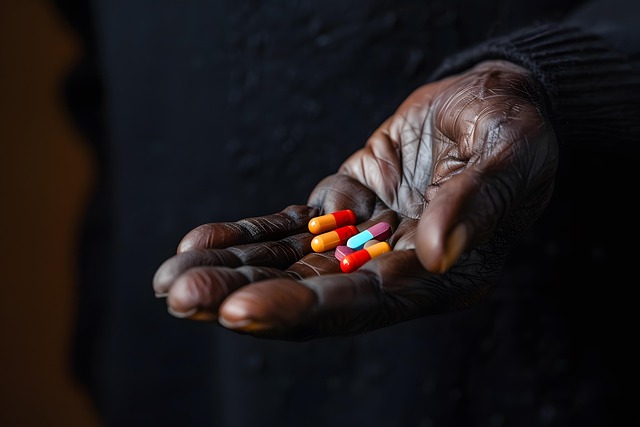GLP-1 receptor agonists (GLP-1 drugs) are medications that mimic natural hormone GLP-1 for managing type 2 diabetes, offering both metabolic benefits and potential weight loss advantages. They come in injectable (e.g., exenatide, liraglutide) and oral formulations (e.g., semaglutide, dulaglitide). Dosing regimens vary by drug, with factors like pharmacokinetics and patient needs guiding selection. Newer oral GLP-1 drugs offer enhanced convenience over injections. Optimizing treatment involves strategic dosing frequency and duration, tailoring to individual patients' needs, side effects, and responses. Common side effects include gastrointestinal issues, manageable through dietary adjustments and healthcare guidance. The future of GLP-1 drug therapy looks promising with personalized dosing, combination treatments, and innovative administration methods under active research.
GLP-1 receptor agonists have emerged as powerful tools in managing type 2 diabetes, offering significant benefits in blood sugar control. This comprehensive guide delves into the intricate world of GLP-1 drugs, exploring their mechanism of action and diverse types. We dissect critical dosing considerations, administration routes, and strategies for optimizing treatment outcomes. Additionally, we examine patient selection, adverse effects, and future prospects, including personalized dosing and combination therapies, providing healthcare professionals with a detailed resource on these innovative treatments.
Understanding GLP-1 Receptor Agonists: Mechanism of Action

GLP-1 receptor agonists are a class of medications designed to mimic the effects of the natural hormone glucagon-like peptide-1 (GLP-1). These drugs play a significant role in managing type 2 diabetes and have gained attention for their potential benefits beyond blood sugar control. The mechanism of action involves binding to GLP-1 receptors, which are primarily located in the brain and intestines. This binding stimulates various physiological responses, including increasing insulin secretion in a glucose-dependent manner and slowing gastric emptying, leading to improved glycemic control.
The agonists enhance insulin release when blood sugar levels are high, providing a more stable source of glucose control. Additionally, they can reduce appetite and slow digestion, contributing to weight management. This dual action makes GLP-1 drugs an attractive option for diabetes treatment, offering both metabolic benefits and potential weight loss advantages.
Types of GLP-1 Drugs: A Comprehensive Overview

GLP-1 receptor agonists, or GLP-1 drugs, are a class of medications designed to mimic the effects of the natural hormone glucagon-like peptide-1 (GLP-1). These drugs play a significant role in the management of type 2 diabetes and have gained attention for their potential benefits beyond blood sugar control. The market offers various types of GLP-1 drugs, each with unique characteristics and mechanisms of action. Among them are injectable medications that directly stimulate GLP-1 receptors, such as exenatide and liraglutide, which are synthetic versions of GLP-1 or its fragments. These injections provide sustained effects, making them popular choices for long-term diabetes management.
Oral GLP-1 drugs, like semaglutide and dulaglitide, represent another significant advancement. They undergo intestinal absorption and subsequent metabolic processing, offering a more convenient administration route compared to injections. These oral medications demonstrate superior efficacy in lowering blood sugar levels and have shown promising results in weight management, expanding their potential use beyond diabetes treatment.
Dosing Considerations for Different GLP-1 Agonists

When considering the dosing of GLP-1 receptor agonists, it’s crucial to recognize that different drugs within this class may have distinct recommended dosages and administration schedules. These variations are often driven by their pharmacokinetic properties and individual patient factors. For instance, exenatide, a popular GLP-1 agonist, is typically administered once weekly via subcutaneous injection, with initial doses ranging from 5 to 20 micrograms, allowing for flexibility based on the patient’s response. In contrast, liraglutide, another GLP-1 drug, is usually started at lower doses and gradually titrated up to a maintenance dose of 1.8 mg daily or 0.6 mg weekly, offering a more gradual treatment approach.
The choice of dosing regimen depends on various factors, including the specific GLP-1 agonist, patient characteristics, and therapeutic goals. Patients and healthcare providers must work together to monitor response and adjust dosages accordingly. Regular follow-ups are essential to ensure optimal blood glucose control while minimizing potential side effects associated with these medications. Understanding the unique dosing considerations for each GLP-1 drug is vital for effective management of diabetes and related conditions.
Administration Routes: Injectable vs. Oral Formulations

The administration route plays a significant role in the effectiveness and patient preference of GLP-1 receptor agonists. While injectable formulations have been the traditional method, providing precise dosing and quicker onset, recent advancements have led to the development of oral GLP-1 drugs. These oral medications offer a more convenient option for patients, allowing them to self-administer without the need for frequent injections.
Oral formulations, in particular, have gained attention due to their potential to improve adherence and quality of life. They are designed to resist enzymatic degradation in the gut, ensuring better bioavailability. This shift towards oral GLP-1 drugs could significantly impact the management of type 2 diabetes, providing patients with a more sustainable and patient-friendly treatment option compared to traditional injectables.
Optimizing Treatment Outcomes: Frequency and Duration of Doses

Optimizing treatment outcomes with GLP-1 receptor agonists involves carefully considering the frequency and duration of doses. These factors play a crucial role in managing blood sugar levels effectively, promoting weight loss, and reducing cardiovascular risks associated with type 2 diabetes. Studies have shown that adhering to prescribed dosing schedules can significantly enhance the therapeutic benefits of GLP-1 drugs.
Frequent administration, often twice daily, ensures steady activity at the GLP-1 receptor, leading to better glycemic control. Duration of each dose also matters; extended-release formulations provide a more consistent effect over 24 hours, potentially simplifying patient adherence and improving overall treatment outcomes. Healthcare providers should work with patients to tailor these parameters based on individual needs, side effects, and response to therapy, thereby maximizing the advantages of GLP-1 drugs in managing diabetes.
Patient Selection and Individualized Therapy with GLP-1 Drugs

The selection of patients most suitable for GLP-1 drug therapy is a key consideration. These medications are primarily indicated for individuals with type 2 diabetes who meet specific criteria, such as inadequate glycemic control despite lifestyle modifications and often, certain cardiovascular risk factors. Patient characteristics play a crucial role in tailoring treatment; age, body mass index (BMI), and the presence of comorbidities can influence the choice of GLP-1 receptor agonist.
Individualized therapy ensures that each patient receives a personalized dose and administration schedule based on their unique needs. Healthcare providers should consider factors like patient adherence, potential side effects, and cost-effectiveness when making these decisions. This tailored approach maximizes the benefits of GLP-1 drugs, offering improved glycemic control and potentially reducing long-term cardiovascular risks in select patients.
Common Adverse Effects and Management Strategies

GLP-1 receptor agonists, while effective in managing diabetes and weight, are not without their side effects. Common adverse effects include nausea, vomiting, diarrhea, abdominal pain, and constipation – often referred to as gastrointestinal (GI) issues. These symptoms typically occur during the initial weeks of treatment and tend to lessen over time.
Management strategies involve dietary adjustments, such as increasing fiber intake and staying hydrated, which can help alleviate GI discomfort. Patients are also advised to take GLP-1 drugs with a meal to reduce the likelihood of nausea. In cases where side effects persist or are severe, healthcare providers may adjust the dosage or consider alternative treatments. Regular monitoring by healthcare professionals is essential to ensure optimal dosing and minimize adverse effects, making these drugs safe and effective for long-term use in managing metabolic conditions.
Future Perspectives: Personalized Dosing Regimes and Combination Therapies

The future of GLP-1 receptor agonist therapy looks promising, with a growing focus on personalized dosing regimes. By tailoring treatments to individual patient needs, healthcare professionals can optimize blood glucose control while minimizing adverse effects. This approach may involve incorporating predictive models that take into account factors like genetic makeup, lifestyle, and metabolic profiles.
Additionally, combination therapies that pair GLP-1 drugs with other diabetes medications or devices are an emerging area of interest. Such combinations could offer more comprehensive management of type 2 diabetes, potentially leading to improved long-term outcomes for patients. As research progresses, these innovative strategies may revolutionize the way GLP-1 drugs are administered and significantly enhance patient care.
